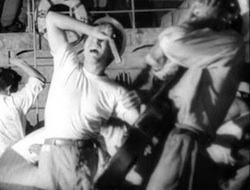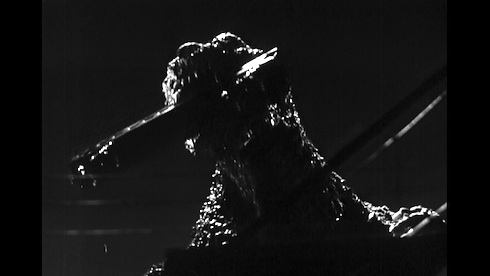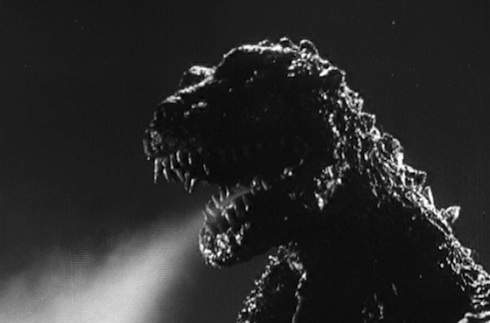If social science fiction serves to provide a fanciful vessel for commentary, then the premise of Gojira might be one of the best examples ever of social commentary riding on the back of cinematic science fiction. But like many of the beloved monsters we’re discussing this week, Godzilla himself is a beast as maligned by misconceptions as he is inundated with nuclear radiation. As a child, I certainly didn’t see the original Godzilla film first, and when I did, I probably found it to be considerably more boring than say Godzilla Vs. King Kong or Godzilla Vs. the Cosmic Monster or the mega-monster orgy Destroy All Monsters! The inception then of this devastating dinosaur is not kid-friendly at all, because, it is, not surprisingly, a very serious film.
But unlike some other classic monster movies, Gojira is singular because it truly seems to lack a main character. Even the beast himself doesn’t have enough screen time or enough of an arc to warrant that distinction. But it’s okay, because Gojira isn’t about people, instead it’s a movie that depicts a specific event, and in this way, succeeds in defending its much-deserved title as a classic and relevant film.
(Note: While I am aware that the word “Gojira” has nothing to do with a “God-zilla” and instead is a combination of the Japanese words for “gorilla” and a “whale,” I am still an American, and in my head, the monster’s name is “Godzilla.” Also in the restored and subtitled Japanese film, the subtitles call him that, too. So, in this article when I talk about that monster himself, I’ll call him”Godzilla.” When I reference the film as a film, I’ll call it by its proper name; Gojira.)
 Gojira opens with a series of extremely economical, effective, and genuinely frightening scenes of various Japanese ships being destroyed at sea under mysterious circumstances. Fishermen and deck hands shout that the “sea just blew up!” Government speculation as to the cause of this devastation ranges from roving sea mines, to an undersea volcano. Notably absent from these possible non-Godzilla explanations is an attack from a foreign nation. This is fascinating because while Gojira is undeniably a political film, it seems fairly aware that it needs to stand up as a movie first, and political statement second. And so, the narrative is fairly careful to avoid connecting all the relevant the dots for the audience, at least at the beginning. You’re not supposed to feel like Godzilla equals nuclear war, instead, as a metaphor, Godzilla is more representative of fall-out than the bomb itself. But how could fall-out become a specific event, instead of the lingering terrible consequence it is in real life? Gojira postulates that if you had a prehistoric creature living in the depths of the ocean, it might be roused and super-charged by “nuclear testing.” This euphemism is the nice way the filmmakers decided to reference the bombs America dropped on Nagasaki and Hiroshima. You’ve got to hand it everyone involved in this film. For as close as it was made to horrific events that ended WWII, the movie has some class, despite the super-heavy message it carries.
Gojira opens with a series of extremely economical, effective, and genuinely frightening scenes of various Japanese ships being destroyed at sea under mysterious circumstances. Fishermen and deck hands shout that the “sea just blew up!” Government speculation as to the cause of this devastation ranges from roving sea mines, to an undersea volcano. Notably absent from these possible non-Godzilla explanations is an attack from a foreign nation. This is fascinating because while Gojira is undeniably a political film, it seems fairly aware that it needs to stand up as a movie first, and political statement second. And so, the narrative is fairly careful to avoid connecting all the relevant the dots for the audience, at least at the beginning. You’re not supposed to feel like Godzilla equals nuclear war, instead, as a metaphor, Godzilla is more representative of fall-out than the bomb itself. But how could fall-out become a specific event, instead of the lingering terrible consequence it is in real life? Gojira postulates that if you had a prehistoric creature living in the depths of the ocean, it might be roused and super-charged by “nuclear testing.” This euphemism is the nice way the filmmakers decided to reference the bombs America dropped on Nagasaki and Hiroshima. You’ve got to hand it everyone involved in this film. For as close as it was made to horrific events that ended WWII, the movie has some class, despite the super-heavy message it carries.
But if Godzilla himself serves as a metaphor for not only the horrors of nuclear war, but also more specifically, an embodiment of nuclear fall-out, then there is something paradoxically hopeful about the premise of Gojira. Because if fall-out is now made into a monster, it becomes a living thing, and a living thing can die, or more importantly be killed. However, Godzilla isn’t just a metaphor, he’s a living thing too, and also a kind of victim. Several discussions in the film revolve around whether or not the monster should even be killed in the first place. Dr. Yamane, the aging and wise paleontologist, is super-bummed out that the consensus among the powers-that-be seems to one with this message: Godzilla must die.

Though it doesn’t follow any of its human characters closely enough to create a realistic story, there is some interesting drama occurring during the impending invasion from Godzilla. After a lot of jostling between government officials, members of the press, victims of various attacks, and fisherman who know the score, the narrative eventually settles around the previously mentioned Dr. Yamane, his daughter Emiko, her fiancé Dr. Serizawa, and her new real lover Ogata, a captain of a salvage ship. Just before Godzilla eventually makes his initial landfall, Emiko goes to see Serizawa with the implicit purposes of letting him know it’s all over and she’s going to start shacking up with Ogata. Complete with an eyepatch, Serizawa exudes a very Dr. Frankenstein madness. References are made to how “the war changed him” (like Godzilla!) and Serizawa’s inventions certainly have a lot in common with the switches and levers of Frankenstein’s lab. Specifically, he’s invented the Oxygen Destroyer, a gizmo he creepily demonstrates to Emiko when she comes to visit. I bet you can figure out what the Oxygen Destroyer does based on its name. (I’ll tell you this much, it DOES NOT make pancakes in nifty shapes.)

Either way, between the reveal of the Oxygen Destroyer and the attack from Godzilla, poor Emiko just can’t seem to find the time to break the bad news. Though she has short coversation with Ogata about this, I sort of wish it had been longer. It can be paraphrased thusly:
“Did you tell him or what?”
“Didn’t have a chance to.”
“Why?”
“Godzilla! Duh!”
“Oh come on, Godzilla’s not real. Oh wait! Shit! There’s Godzilla! Yeah, let’s sort this out later.”
Kidding aside, this human conflict does create some great stuff because ultimately it is Ogata who gets pissed off when Serizawa gets cold feet about using the weapon to kill Godzilla. The notion of proliferation of doomsday weapons is pretty clear, and though Godzilla is technically vanquished, the looming “at what cost?” question is asked pretty clearly.
Famously, much of the inspiration for Gojira came from King Kong, even though its visual effects were accomplished completely differently. As a kid I remember thinking stop-motion was good and guys in rubber-suits were bad, in terms of realism. There was a paradox here because while I liked Godzilla a whole lot better than King Kong, it bothered me to know that it was just a guy in a suit. However, upon rewatching the movie, I have to say I was genuinely surprised by how good it looks. When Godzilla first pokes his head up over the mountain, I expected to laugh, instead I caught myself gasping. There’s something about the casual and slow way monsters are introduced in old movies that can’t ever be properly homaged or recreated. The other thing to remember about the FX of Gojira isn’t just the guy in the monster suit, but the miniatures he has to destroy! My favorite example of this comes early in the film, before we’ve even seen Godzilla’s face. The big G has ravaged an island and the most damning evidence that a monster has been stomping around is a smushed helicopter lolling on the beach. The way the camera holds on this image before slowing fading into the next scene represents a pretty ballsy faith in the model-makers and FX folks in general. It’s nice; because in this era of movies, you didn’t need to be convinced any of this stuff was real.

It’s not like Godzilla “looks” real either. If the buildings or helicopters looked more realistic than Godzilla, none of this stuff would work. Fortunately, the characters and their conflicts are similar in texture to everything else, making nearly ever aspect of this film consistent with itself. For all these reasons, and also that fantastically iconic roar, Gojira, will always be the king of monsters.
(For one of the best accounts (albeit a fictional one) of the making of Gojira, I can’t recommend Jim Shepard’s short story “Gojira, King of Monsters” enough. It can be found in his 2011 collection: You Think That’s Bad, which you can read all about here.)
Ryan Britt is the staff writer for Tor.com.











The Big Guy is a huge part of our cultural subconcious.
After the recent earthquake and tsunami that devastated Japan and trashed a nuclear plant, several of us looked at each other and said “we’ve seen this movie before, now’s not a good time to visit Tokyo. Is that a three-toed footprint in the wreckage of the power plant?”
Some of my daughter’s earliest words, after being left alone with me and cable on halloween afternoon, were “Mommy Mommy, Godzilla eats Tokyo!”
You can keep your Freddies, Jasons, and other interchangible slashers: Godzilla is the King of the Monsters, and the Master of the era of “scary does not equal grisly.”
The fishing boat getting attacked at the beginning of the film was actually somewhat political, from what I understand. It was based on what happened to a Japanese fishing boat, Lucky Dragon No. 5 (Daigo Fukuryu Maru) in March of 1954. Godzilla was released in November of that year.
The ship and its crew was contaminated by an American H-bomb test on the Bikini Atoll. The radiation zone ended up being bigger than expected. The entire crew was contaminated by fallout, with the first crew member dying that September.
This would have been a pretty well-known event by the time the movie was made, made more controversial by how the U.S. handled the incident, and would later help start the Japanese anti-nuclear movement. Basically, I don’t think the nuclear testing in the film was a euphemism.
Also, keep in mind that the film was made only two years after the U.S. occupation of Japan ended. During that at least part of that period (might have been the whole period, been a while since I’ve read about this), the American occupiers exerted heavy control over how the U.S. and its forces could be depicted in Japanse film. Japanese audiences of the time would, I’d expect, have been aware of this, and would have been used to films made under that censorship, so they might not have needed all the dots to be connected. (Though that is admittedly speculation on my part.)
As much as I like the far more serious original, Godzilla: Final Wars is still the movie that comes to mind whenever I think of the big guy. Something about seeing Godzilla face down the American Godzilla while heavy metal music plays just gets me every time, as does the American captain who speaks in English throughout the entire movie despite everyone else speaking only Japanese.
It would take until 2001 and a film with the extremely unwieldy title Godzilla, Mothra and King Ghidorah: Giant Monsters All-Out Attack before Godzilla again represented something significant. It’s also the only film besides the first one in which Godzilla is actually scary. The scene with the girl in the hospital still gives me chills.
What SF said @2 makes a lot of sense. There was nuke testing going on all over the place when Gojira was released, so the movie is about a lot more than Hiroshima and Nagasaki.
This is a brilliant movie. It’s nearly the only Godzilla movie I’ve seen (barring Godzilla vs. Megalon “watched” in high school after all exams, and that piece of utter shite that the Americans tried in ’98), and I saw the original version in the Castro Theater in SF, so I came to it without baggage. To me, it was more reminiscent of Kurosawa than ye olde typical monster movie. Interesting stuff was happening, but the essential questions were about humanity.
I’m always fascinated by what English words show up in Japanese flicks. /Oxygen Destroya/? Was pointed, IMO, that the ultimate weapon here didn’t have a Japanese name.
It’s been awhile since I saw it, but I seem to recall it’s main character being Dr. Serizawa with his internal struggle. There was a bit when he and Ogata fight and he causes Ogata damage right by the same eye he himself lost, and has a delightful “am I becoming a monster” moment without words… Also, dude is dead sexy. I do need to rewatch: I remember that it was refreshing that basically all the characters are valuable people with good motives, so that the story is about the forces at work and not (as in some cheaper movies) a foolish scenery-chewing bad guy…
Speaking of the Godzilla roar, it was created by scraping metal along the wires of a piano, then distorting and manipulating the audio tape. Fun fact – the same technique created the TARDIS engine noise!
Madeline@7: I can’t necessarily speak for that era, but these days there’s not much significance to something having an English title in Japan. It’s all over the place, and nearly impossible to avoid.
@7 Madeline – There actually are some connections between “Gojira” and Kurosawa.
The director, Ishiro Honda was a friend and colleague of Kurosawa’s. He worked as an assistant director on Kurosawa’s “Stray Dog” back in the 40s, then started to work with him again in 1980 with “Kagemusha.” And I think he specifically worked on the nuclear-themed “Fuji in Red” segment in Kurosawa’s late film, “Dreams,” which is reminiscent of “Gojira.”
The composer, Akira Ifukube (who also created Godzilla’s roar), composed the score for “The Quiet Duel,” one of Kurosawa’s postwar films.
Special effects director Eiji Tsuburaya worked on Kurosawa’s “Throne of Blood” (Macbeth adaptation) and “The Hidden Fortress” (partial inspiration for Star Wars).
One of the lead actors, Takeshi Shimura, was one of Kurosawa’s two regular leading men in his black and white period (along with Mifune).
And in terms of classical Japanese film in general, the cinematographer, Masao Tamai, worked on some of Mikio Naruse’s films in the 50s and early 60s, including “Late Chrysanthemums” and “When a Woman Ascends the Stairs.” (Naruse is one of the big names in Japanese film of the period, along with Kurosawa, Ozu and Mizoguchi.)
ZetaStriker@9: I wonder still, though… Noticed recently when I was watching “Tokyo Godfathers” that the word for “homeless” is apparently “homarisu”. What did the Japanese call homeless people before that? Something more loaded, like “bums”? Or is the whole class of people a post-war thing?
SF@10: That is a cool comment. I probably recognized Shimura subconsciously, but all the rest there is really neat to know.
Ryan said, “Godzilla is more representative of fall-out than the bomb itself. But how could fall-out become a specific event, instead of the lingering terrible consequence it is in real life? Gojira postulates that if you had a prehistoric creature living in the depths of the ocean, it might be roused and super-charged by “nuclear testing.” This euphemism is the nice way the filmmakers decided to reference the bombs America dropped on Nagasaki and Hiroshima. You’ve got to hand it everyone involved in this film. For as close as it was made to horrific events that ended WWII, the movie has some class, despite the super-heavy message it carries.”
SERIOUSLY? If you’ve ever seen a mushroom cloud on the screen, and Enola Gay wasn’t in the accompanying footage, it was ‘nuclear testing’… not the bombing of Hiroshima and Nagasaki.If its taking place over water, with tiny ships in the blast, it is ALWAYS ‘nuclear testing’…
Nuclear testing is not a euphemism, its a fact. The US did it, the French did it, the British did it, the Russians did it, and 4 of those 5 did it in the south Pacific where Gojra was supposedly spawned.
I’m happy to conceed the role of the Hiroshima and Nagasaki bombing might have played in the writing of Gojira, but the references to nuclear testing in the pacific are real, topical references, things happening in the world at the time the movie was shot and presented.
When you get such an obvious thing wrong, I can’t help but think less of everything else you say about the movie.